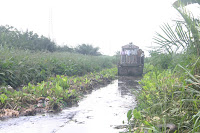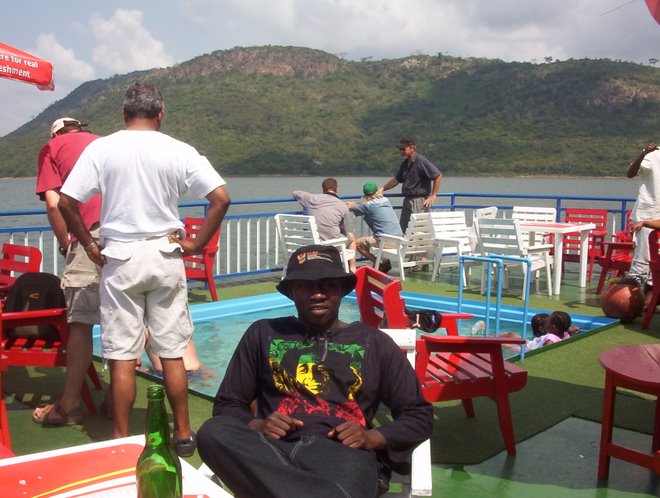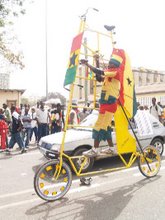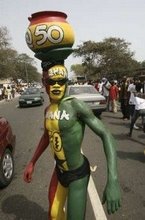Poor drainage halts train services in Kumasi
Picture shows rail tracks submerged in floods with a locomotive trying to pass through it.
RUNOFF water always engulfs the rail tracks at Kaase after the slightest drizzle due to a major drainage problem in the area of the rail tracks.
The problem has gradually contributed to inactivity at the main Kumasi Railway terminal.
This is because the rail tracks get submerged under volumes of water at the Kaase level crossing area at the slightest rainfall in Kumasi.
As a result trains are unable to cross the Kaase portion of the rail tracks anytime it rains. This has resulted in erratic operations of the sleeper, commuter and haulage trains, leading to public disinterest and low patronage.
There are no intercity services currently running. The sleeper and commuter trains are no more functioning with the exception of intermittent haulage of goods such as cocoa. The railway station in Kumasi is currently engulfed with weeds as a result of the inactivity at the place.
Information gathered by the Daily Graphic indicates that many of the staff have been moved from Kumasi to Tema and Awaso where activity in the sector is slightly vibrant than Kumasi.
The Kaase portion of the main route from Kumasi to Takoradi is not accessible during rainy days as the rail tracks get engulfed by drainage water at the slightest incident of a rainfall.
The drainage problem at the Kaase level crossing has come about as a result of the Kumasi Metropolitan Assembly’s (KMA) inability to extend the concrete lining of the Subin River from Kejetia to Kaase and beyond to the Suatrem River as a result of what the Assembly terms as insufficient funds.
The KMA in its attempt to ensure free flow of water in the Subin River lined the base of the river with concrete from Kejetia to Kaase but refused to extend the project beyond Kaase to the Suatrem River, with the excuse that it had run out of funds.
As a result, when it rains, the rain water flows smoothly in the concrete drains from Kejetia and adjoining areas to Kaase. But when it gets to Kaase, the water is unable to travel with same speed as a result of silt in that portion since there is no concrete lining at that portion thus the area gets flooded. Trains are normally unable to move through the volumes of water that accumulate on the tracks. When they do, the traction motors, which is the power house under the locomotive and are very expensive gets submerged under water and become defective.
Trains are normally unable to move through the volumes of water that accumulate on the tracks. When they do, the traction motors, which is the power house under the locomotive and are very expensive gets submerged under water and become defective.
Investigations at the Railway offices in Kumasi have indicated that this has led to the destruction of many locomotives, which tried to move through the water.
Railway services have not developed much beyond what was established during the colonial period to cart cocoa and timber from the hinterland to the ports at Takoradi hence Kumasi is served by railway lines to Accra and Takoradi. Because of the barrier mountain range just to the north, the rail system does not yet go further to the north.
A source as the Kumasi railway station told the Daily Graphic that for them to run the commuter service, they need a regular and punctual time.
However because of the perennial problems with flooding, trains from Takoradi were many of the times held at Bekwai or Aduadem, which is the nearest substation to Kaase till the level of water subsided.
At times it could happen for days and there was no way you can run a shuttle service with this problem of perennial flooding and inconsistency in the service, the source said.
It said the public has gradually lost confidence in the Ghana Railway Corporation (GRC) with its train service and has opted for road transport. This is because when passengers are unable to be carried to Kumasi by the train, they spend an extra cost on road to get to Kumasi, when they are held at Bekwai or Aduadem as a result of flooding on the tracks.
The source said the Takoradi sleeper service has been suspended as of now because passengers are most of the times brought to Bekwai or Obuasi for them to continue the rest of the journey on road as a result of flooding on tracks between Bekwai and Kumasi.
It said the level of train activity in Kumasi has gone down tremendously in the last two years and that there was the need to find a solution to the flooding situation at Kaase so as to enable smooth running of the trains.
The source indicated that the KMA had been contacted to come to the aid of the railway system with respect to the flooding but the assembly was yet to respond positively.
Information also gathered by the Daily Graphic indicates that the Ministry of Ports, Harbours and Railways was aware of the problem of the perennial flooding and the sector Minister had paid a visit to the flooding site but the Ministry was yet to also respond positively to the problem.








































No comments:
Post a Comment